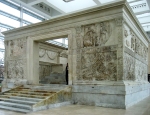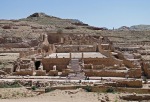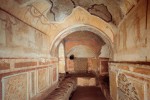Concurrent Dates
| 776 BCE | Rome is Founded |
| 147 BCE | Greece comes under Roman control |
| 44 BCE | Murder of Julius Caesar |
| 30 BCE | Defeat of Cleopatra and Mark Antony by Octavian (Augustus Ceasar) |
| 325 CE | Council of Nicea, Christianity is the sanctioned religion of Rome |
Target Concepts
- Roman architecture was made possible through two key innovations: the arch and concrete
- Roman art and architecture show influence from both the Greeks and the Etruscans
- Romans used art and architecture as propaganda
- Over the length of the Roman Empire, their artistic style will transition from a realistic depiction of individuals to a stylized approach
- This shift from realism to stylization reflects changing needs and aesthetics in Roman culture
- Roman funereal art is significant because it serves as the model for later artistic periods
Architecture Terms
Cement and Concrete
Revetment
Arch
Vault
- Barrel Vault
- Groin Vault
- Annular or Ring Vault
- Dome
Apse
Before Rome: The Etruscans
Chapter 9
Sarcophagus of the Spouses
Italy. 6th century BCE painted terracotta 4’ x 7’
Tomb of the Triclinium
Italy. 5th century BCE tufa and fresco
Temple of Minerva, master sculptor Vulca
Italy. 6th century BCE original temple of wood, mud brick, or tufa. Terra cotta sculptures
Plinth, portico
Apollo, Master sculptor of Vulca
From the Temple of Minerva
Italy. 6th century BCE terra cotta
The Roman Republic
Chapter 10
6th – 1st centuries BCE
Roman Culture and Society
Romulus and Remus, patrician, plebian
The Forum of Pompeii
Pompeii, Italy. 2nd century BCE
Corinthian capital, cardo, decumanus, basilica, capitoleum
The House of the Vetti
Pompeii, Italy. 2nd century CE
atrium, impluvium, cubiculum
Frescoes from the House of the Vetti
Italy. 2nd century BCE buon fresco
Faux texture, linear perspective, atmospheric perspective
Alexander Mosaic (Battle of Issus), Roman copy of a painting by Philoxenos of Eretria
Italy. 2nd century BCE mosaic 9’x17’
Tesserae, foreshortening
Head of a Roman Patrician
Italy. 1st century BCE marble 1’ high
Imagines, Veristic/Verism
Temple of “Fortuna Virilis” (Temple of Portunus)
Italy. 1st century BCE
Eclectic
Imperial Rome
Chapter 10
1st c BCE thru 3rd c CE
Julius Caesar, Octavian (Augustus), Pax Romana
Portrait of Augustus as general
Italy. 1st century BCE marble copy of bronze original 7’ high
Ara Pacis Augustae (Altar to the Augustan Peace)
Italy. 1st century BCE
Pax Augusta/Pax Romana, pilaster
- Personification of Tellus (?)
- Procession of the Imperial Family
Arch of Titus
Italy, 1st century CE marble
Triumphal Arch
Colosseum (Flavian Amphitheatre)
Italy. 1st century CE 160’ high at its highest point
velarium, corinthian capital
The Forum and Markets of Trajan, by Apollodorus of Damascus
Part of the Forum of Trajan
Rome, Italy. 2nd century CE
- Column of Trajan
Pantheon
Rome, Italy. 2nd century CE dome is 142’ in diameter and 142’ tall
Oculus, coffers, niche, gilded
The Treasury of Petra
Petra, Jordan. 2nd century CE façade is 130’ high by 90’wide
Battle of Romans and barbarians (Ludovisi Battle Sarcophagus)
Italy. 3rd century CE marble 5’ high
Mithras
Catacomb of Priscilla
Italy, 5th century CE excavated tufa and fresco
Santa Sabina
Italy, 5th century CE brick and stone, wooden roof
Nave
- Sarcophagus of the Spouses
- Tomb of the Triclinium
- Temple of Minerva
- Apollo
- The Forum of Pompeii
- The House of the Vetti
- Alexander Mosaic
- Head of a Roman Patrician
- Temple of Fortuna Virillis
- Portrait of Augustus as General
- Ara Pacis Augustae
- Personification of Tellus
- Procession of the Imperial family
- Colosseum
- Forum of Trajan
- Market of Trajan
- Column of Trajan
- Pantheon
- Pantheon, interior
- Treasury of Petra
- Great Temple of Petra
- Ludovisi Battle Sarcophagus
- Basilica Nova
- Portrait of Constantine
- Catacomb of Priscilla
- Orant
- Santa Sabina, exterior
- Santa Sabina, interior




























